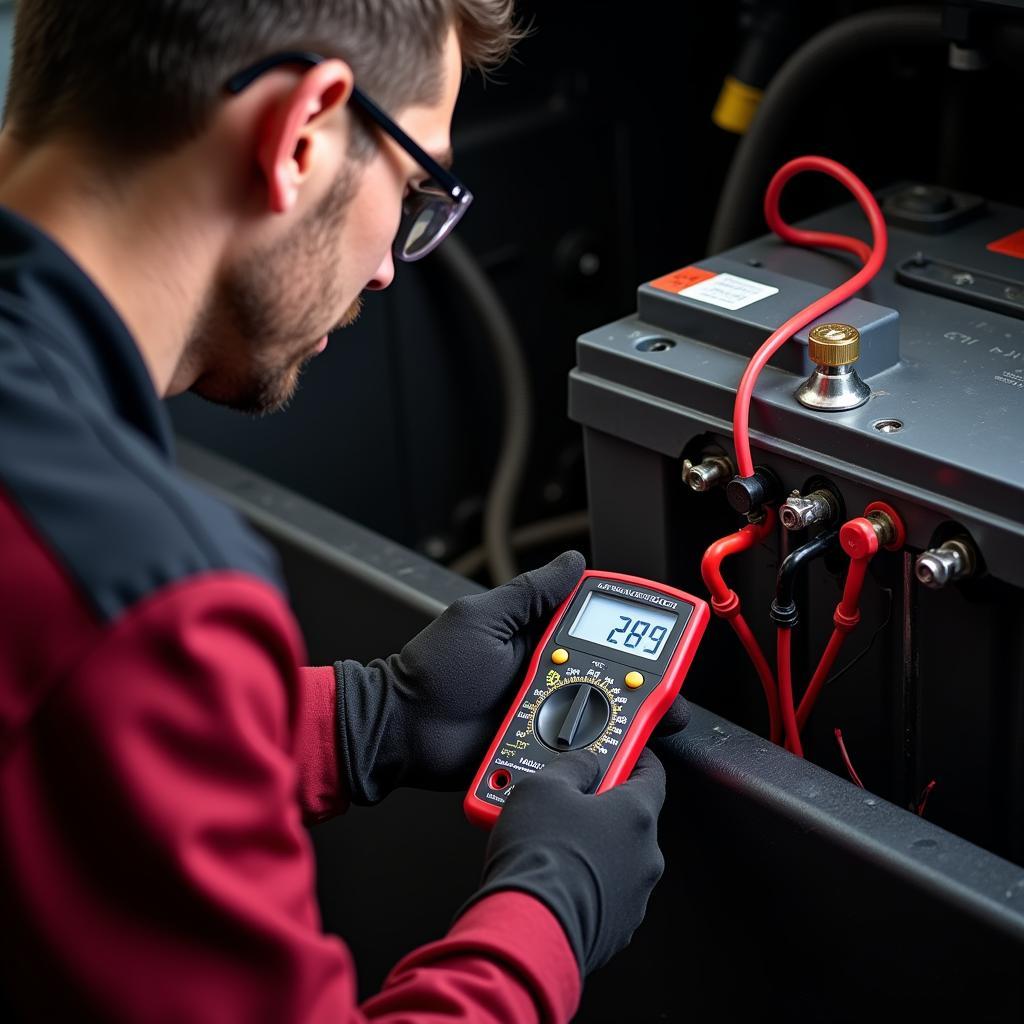Diesel batteries going dead can be a frustrating experience, leaving you stranded and wondering what went wrong. This issue can stem from a variety of causes, ranging from simple parasitic draws to more complex problems with the charging system or even the battery itself. Understanding these potential issues is crucial for effectively diagnosing and resolving the problem.
Why are My Diesel Batteries Dying?
Diesel engines require robust batteries due to their higher compression ratios and the demands of glow plugs or grid heaters, especially in cold weather. This increased demand can put extra strain on the batteries, making them more susceptible to failure. Several factors can contribute to diesel batteries going dead:
- Parasitic Draws: Even when the engine is off, certain electrical components like the clock, radio memory, or alarm system continue to draw power, slowly draining the battery. A faulty component or a wiring issue can amplify this draw, leading to a dead battery.
- Faulty Alternator: The alternator is responsible for recharging the battery while the engine is running. A malfunctioning alternator won’t effectively charge the battery, eventually leading to its demise.
- Bad Battery: Over time, batteries degrade and lose their ability to hold a charge. Extreme temperatures, both hot and cold, can accelerate this process. A bad battery may not hold a charge even after being jumped or charged.
- Glow Plug/Grid Heater Issues: Faulty glow plugs or grid heaters can draw excessive current, particularly during cold starts, putting a heavy strain on the batteries.
- Excessive Key-On Time: Spending prolonged time with the key in the “on” position without starting the engine can drain the battery, especially if accessories like the radio or lights are also on.
 Checking Diesel Battery Terminals
Checking Diesel Battery Terminals
How to Diagnose a Dead Diesel Battery
Identifying the root cause of a dead diesel battery requires a systematic approach:
- Visual Inspection: Start by checking the battery terminals for corrosion or loose connections. Clean the terminals with a wire brush and baking soda solution if necessary.
- Battery Test: Use a multimeter or a battery tester to check the battery’s voltage. A fully charged battery should read around 12.6 volts. A significantly lower reading indicates a weak or dead battery.
- Alternator Test: With the engine running, check the voltage at the battery terminals. A healthy alternator should maintain a voltage between 13.5 and 14.5 volts. A lower reading suggests a faulty alternator.
- Parasitic Draw Test: With the engine off and all accessories turned off, connect a multimeter in series with the negative battery cable. A reading above 50 milliamps may indicate a significant parasitic draw.
- Glow Plug/Grid Heater Test: Check the resistance of the glow plugs or grid heaters using a multimeter. A high resistance or an open circuit indicates a faulty component.
Preventing Diesel Batteries from Dying
Taking proactive measures can help extend the lifespan of your diesel batteries and prevent unexpected breakdowns:
- Regular Battery Maintenance: Clean the battery terminals regularly and apply a protective coating to prevent corrosion. Have the battery tested periodically to assess its health.
- Minimize Parasitic Draws: Avoid leaving accessories on when the engine is off. Address any known electrical issues promptly.
- Limit Key-On Time: Don’t spend excessive time with the key in the “on” position without starting the engine.
- Proper Cold Weather Starting: Follow the manufacturer’s recommendations for cold weather starting, including using the glow plugs or grid heaters appropriately.
Expert Insights on Diesel Battery Maintenance
“Regularly cleaning your battery terminals is crucial for preventing corrosion, which can significantly impact battery performance,” says John Davis, a certified automotive technician with over 20 years of experience. “It’s a simple task that can save you a lot of trouble down the road.”
“In cold weather, make sure you give your glow plugs or grid heaters enough time to warm up before starting the engine,” adds Sarah Miller, an electrical systems specialist. “This can help reduce the strain on your batteries and prevent premature failure.”
Conclusion
Diesel batteries going dead can be a common problem, but understanding the underlying causes and implementing preventative measures can help you avoid this frustrating experience. Regular maintenance, prompt diagnosis, and addressing any underlying issues can keep your diesel engine running smoothly. By following the advice outlined in this article, you can extend the life of your batteries and enjoy trouble-free driving.
FAQ
-
How long do diesel batteries typically last? Diesel batteries generally last 3-5 years, depending on usage and environmental conditions.
-
Can I jump-start a diesel with a gas engine? Yes, you can jump-start a diesel with a gas engine, but ensure both batteries have the same voltage (typically 12 volts).
-
What are the signs of a bad alternator? Dim headlights, flickering dashboard lights, and a whining noise from the engine bay can indicate a failing alternator.
-
How can I find a parasitic draw? Use a multimeter to measure current draw with the engine off and systematically disconnect fuses to isolate the circuit causing the drain.
-
Is it safe to drive with a bad alternator? You can drive a short distance with a bad alternator, but the battery will eventually drain, leaving you stranded.
-
What type of battery is best for a diesel engine? Diesel engines require high-cranking amp batteries, often AGM (Absorbent Glass Mat) or traditional lead-acid batteries designed for heavy-duty applications.
-
How often should I test my diesel battery? It’s recommended to test your diesel battery every 6 months, especially before the onset of winter or summer.


